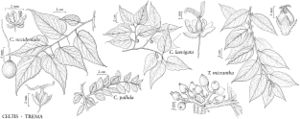Celtis
Sp. Pl. 2: 1043. 175.
Gen. Pl. ed. 5, 467. 1754.
Trees or rarely shrubs, to 30 m; crowns spreading. Bark usually gray, smooth or often fissured and conspicuously warty. Branches without or with thorns, slender, glabrous or pubescent. Leaves: stipules falling early. Leaf blade deltate to ovate to oblong-lanceolate, base oblique or cuneate to rounded, margins entire or serrate-dentate; venation 3(-5)-pinnate. Inflorescences: staminate inflorescences cymes or fascicles; pistillate solitary or few-flowered clusters. Flowers usually unisexual, staminate and pistillate on same plants, along with a few bisexual flowers, pedicellate on branches of current year, appearing in mid or late spring. Staminate flowers: filaments incurved in bud, exserted after anthesis; gynoecium minute, rudimentary. Pistillate flowers: calyx slightly to deeply 4(-5)-lobed; stamens 4-5, inserted on pilose receptacle, included, often nonfunctional filaments usually shorter than in staminate flowers, rarely absent; anthers ovate, face to face in bud, extrorse; ovaries sessile, ovoid, 1-locular; styles short, sessile, divided into 2 divergent, elongate, reflexed lobes, lobes entire or 2-cleft. Fruits fleshy drupes, ovoid or globose; outer mesocarp thick, firm, inner mesocarp thin, fleshy; stones thick walled, ripening in autumn, persisting after leaves fall. x = 10.
Distribution
Tropical and temperate regions, worldwide.
Discussion
Species ca. 60 (6 in the flora).
The hackberries provide important wildlife habitat, forming thickets that give shelter and fleshy drupes that ripen in autumn, persist after leaves fall, and supply winter food for birds and mammals. The treatment presented here is a simplified circumscription of species with no elaboration of infraspecific variation or interspecific hybridization. The group is taxonomically complex and in need of revision.
Selected References
Lower Taxa
Key
| 1 | Branches with thorns; leaf blade usually less than 2 cm wide. | Celtis pallida |
| 1 | Branches without thorns; leaf blade usually much more than 2 cm wide. | > 2 |
| 2 | Leaf blade typically elliptic-lanceolate to ovate-lanceolate, apex sharply acute to acuminate, margins mostly entire. | Celtis laevigata |
| 2 | Leaf blade typically broadly to narrowly ovate to oblong-lanceolate, apex blunt or obtuse to abruptly long-acuminate, acute, or short-acuminate, margins variable. | > 3 |
| 3 | Leaf blade abaxially white tomentose; fruits usually light brown; near San Antonio, Texas. | Celtis lindheimeri |
| 3 | Leaf blade abaxially essentially glabrous or with coarse pubescence mainly on veins; fruits mostly reddish orange to purple; widespread. | > 4 |
| 4 | Leaf blade typically 4.5 cm or less, margins entire or somewhat serrate above middle. | Celtis reticulata |
| 4 | Leaf blade mostly 5 cm or more, margins coarsely serrate for at least part of length. | > 5 |
| 5 | Shrubs or small trees; leaf blade serrate and sparingly toothed toward apex, entire proximally; fruits orange to brown to cherry red. | Celtis tenuifolia |
| 5 | Trees; leaf blade conspicuously serrate to well below middle; fruits dark orange to purple- or blue-black. | Celtis occidentalis |
